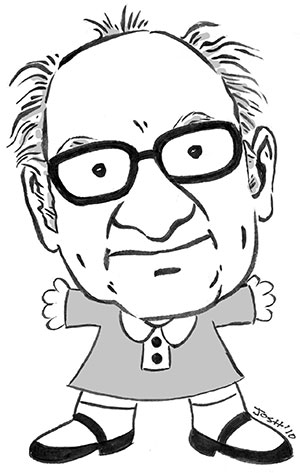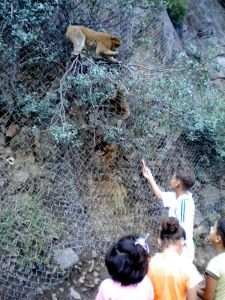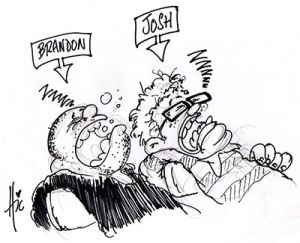October 22
Sitting in the Amman airport for four hours waiting for my connection to Tel Aviv. Now it can be revealed that my last stop is indeed Israel. (The fear was that if, say, Algerian officials knew that I would be traveling to the Jewish state, they would have denied my visa or at least made it difficult for me while I was there. The U.S. Embassy even printed up two separate flight itineraries for me, one which showed me going from Bahrain to Jordan, and another which showed that I was actually continuing on to Tel Aviv.)
I still don’t know what kind of people shop in the airport duty-free areas…
Flipping through Royal Jordanian Airline‘s in-flight magazine during the 20-minute flight from Amman to Tel Aviv, I notice that their flight map of the region shows the names of all the countries in the Middle East — except Israel. It shows some of the key cities — Jerusalem, Tel Aviv — but leaves out the country name. I assume that this is because many people refuse to recognize Israel as such, and insist on continuing to call the country Palestine. So even during my flight over, I am reminded of the many volatile complexities of the land I am going to visit…
Arriving in Israel, I am helped through the customs process by an expediter from the U.S. Embassy. I choose to have my passport stamped, which automatically guarantees that in the future, as long as I continue to use this passport, I will be denied entry to Algeria, Saudi Arabia, Syria, and any number of other Middle Eastern countries.
I arrive in Jerusalem, Israel’s most religious city, on the eve of the Sabbath. Walking around the deserted downtown streets, I keep wondering, “Are all those stray cats Jewish?” They might be ethnically so but don’t appear to be observant. (No kippahs.) They are extremely skittish and paranoid, though, so…?
October 23
A free day in Jerusalem. Looking forward to a thorough self-guided tour of the Old City. Morning at the hotel buffet: the guests all remind me of my dear, departed Grandma Gus and her pals. The International Herald Tribune is a very large broadsheet, but Haaretz is even bigger: it’s gotta be at least 18″ wide. I shudder to think how much food goes to waste everyday from these fancy hotel buffets.
Holy Holy Land, Batman! I’m not religious, but it’s hard not to be awestruck by the historical gravitas of the Western Wall and the Church of the Holy Sepulchre (not to mention some of the sites on Mount Zion). Unfortunately, both times I try to visit the Dome of the Rock it is closed to non-Muslims. I figure I won’t be able to fake it…
Thanks to the Narnia books I love Turkish Delight, and it is plentiful here.
Magic Hour in Jerusalem’s Old City. The light is beautiful.
October 24
Now it can be said: The Giants win the pennant! The Giants win the pennant! The Giants win the pennant!
Just presented my work to 50 mostly bored students at Hadassah College.
After getting burned by a $60 hotel laundry bill in Algeria it’s laundry time in my bathroom sink. Reminds me of my backpacking days.
Walking back from dinner downtown, traffic is held up on King George St. due to a bomb scare. Police come, three loud bangs, and now everything’s moving again.
Tonight at Jerusalem Cinematheque I talk about Harvey Pekar and our 13-year-long creative relationship before a showing of American Splendor. Seeing the film for the first time since his death, it’s stunning to realize how perfect an epitaph it is. It was made while he was still alive, but is a wonderful, loving tribute to him now that he is gone.
Afterward, drinks with Israeli-Belgian cartoonist Michel Kichka, considered by many to the father of Israeli comics. He too knows my French pal Émile Bravo. I look forward to Kichka’s upcoming comics memoir of his father and the Holocaust…
October 25
Two separate workshops today, with “underserved” 8-10-year-olds in Jerusalem & Holon, then meet-and-greet w/Israeli comic pros at the Israeli Cartoon Museum. Whew!
The Kagan Media Center is in a working-class section of Jerusalem, mostly for Jewish immigrant children, many of Eastern European origin.
Both that workshop and the one held in Holon (near Tel Aviv) — at the Lazaros Community Center in the Jessie Cohen neighborhood — go as well as can be expected for my first time with kids that young. I do a modified version of my mini-mini-comics workshop: we come up with characters and then each kid starts their own mini-mini. The kids in Jerusalem show some real promise; the kids in Holon — mostly Ethiopian emigrees — mob me at the end for personalized sketches. One kid also mimes his love for Eminem, Tupac, and Michael Jackson.
The Holon Cartoon Museum is quite impressive — maybe the best one I’ve seen of its kind. And I really enjoy meeting the cartoonists, most of whom would fit quite comfortably in the realm of what we Americans call “alternative comics.” I feel like I am among friends. And I come out of there with a full bag of swag: free copies of the comics of all the participants (who include Shay Charka, Noam Nadav, and Ilana Zeffren)!
October 26
Seaside hotel in Tel Aviv, and there are already people in the water and on the sands at 8 a.m.
Then it’s a talk and workshop for nineteen 9th-graders from the Arab “Mekif” high school in Jaffa. Despite some language and translation difficulties — and typical challenges of working with sulky and/or unruly teenagers — the workshop is fun for everyone.
Rabin Square. Lunching with Daniel Mendelson, my French-Israeli comics pal. Merci toda!
Very nice presentation and Q&A for about 100 students at the Minshar for Art school in Tel Aviv; tomorrow I spend the day in Ramallah, the West Bank.
October 27
At the Jerusalem Hotel, a beautiful Palestinian-owned rustic establishment in East Jerusalem. My last breakfast on this trip. Today I am being programmed by the U.S. Consulate, which is exclusively tasked with dealing with Palestinians. Another example of Jerusalem’s status as a divided city. (The American Center deals with Jewish Israelis.) Until last night, I had no idea what I would be doing today — let alone that I’ll be visiting the West Bank. I’m very excited; after being here for four days, seeing the Jewish side of things, I’m anxious for some some insight into the Palestinian perspective.
Security briefing at the U.S. consulate, and now it’s off to Ramallah. Driving into the West Bank, we speed through checkpoints of Israeli soldiers armed — and armored — to the teeth. VIPs like us breeze through on one road, while the other road for normal folks is backed up for what looks like miles. It is sobering to see the Israeli settlements dotted around the arid hills, overlooking old, long-established Palestinian towns and villages.
Location: PD (e.g. Public Diplomacy) Ramallah. Awesome roundtable with Palestinian political cartoonists from the West Bank and — via Direct Video Conference — Gaza. Participants include Majed Badra, Baha Boukhari, Nedal Hashem, and Mohammad Sabaaneh.
Lunch at a very chic sandwich place in Ramallah, and then A.D. presentation and mini-mini-comics workshop with students of the International Academy of Art Palestine. Once again, I come out with loot: a T-shirt, a mug, and a tote bag. Shukran!
I admit it’s difficult to reconcile the two images of Palestinians I see in the occupied territories. On one hand there are the encroaching Israeli settlements, the many travel restrictions, and the obvious privations of everyday life. On the other hand there is the clearly flourishing city of Ramallah, which is awash in investment and new construction. The city is renowned for its night-life (much better than moribund Jerusalem) and will soon be opening its first five-star hotel. As usual, I leave my new experience more confused than when I started. But this is good.
Back in Jerusalem, I do a quick event at the Consulate’s new East Jerusalem library/outreach center, America House. There I meet with a select group of Israeli Arabs, mostly local artists. Then, we take a crazy trip through Mea Shearim, looking to find a cheap bag to bring home all the swag I picked up during my three-week tour. Success, and then it’s off to the airport.
Ben Gurion. This is it. Heading back home to the good ol’ USA. Wow, Israeli airport security is no joke. They are giving me the third degree about every aspect of my trip. My “official” U.S. State Dept. affiliation has little impact. Even the fact that I have an expediter with me, a U.S. Consulate employee with a special badge who escorts me through all the security and passport checks, does not deter them. They ask me all sorts of questions about the purpose of my trip, why I had visited the three Arab countries, and ask to see official letters from the U.S. Embassy. And the guy keeps asking me the same questions about the purpose of my visit, trying to see if he can catch me in a lie or a contradiction. But I actually enjoy the ordeal, and keep my cool the whole time. Finally, after double X-raying all my bags, looking through all the Hebrew, Arabic, and French comics I have acquired throughout the trip, and practically dismantling my laptop, they let me go through.
Damn! Crappy older plane w/o personal TVs. Now I can only pray I get my whole row to myself so I can sleep.
October 28
I’m baaaaaaaack! Comics Diplomacy 2010 comes to a close. And just in time too as my trusty Tumi backpack just fatally busted a strap.


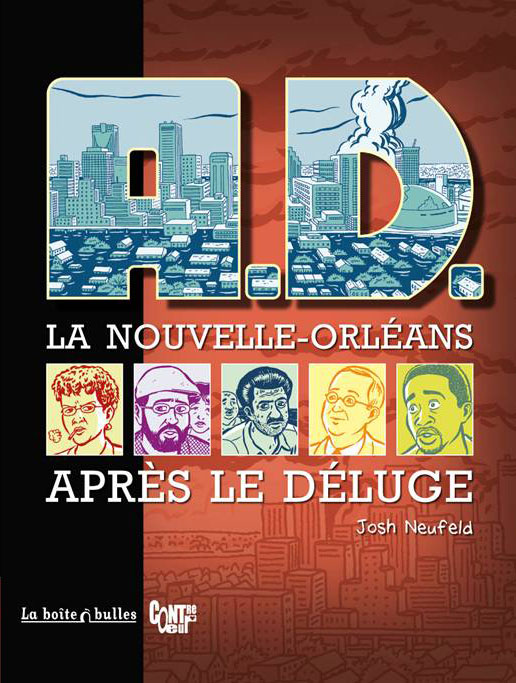
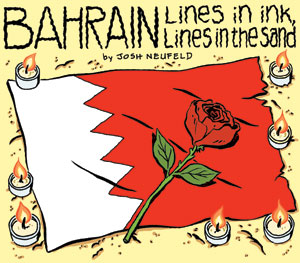
 St. Edward’s University
St. Edward’s University


